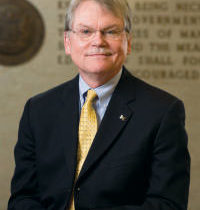Magazine

Changing the Question
by Terrence J. McDonald
Why are “those people” so sensitive about their history and identity?
It’s a question that’s asked frequently these days. It’s also a question that is based on a historical myth, namely the belief that group integration into mainstream American society has been, and still is, easy. Just ask the members of the Detroit Jewish community about their experience, which is so wonderfully captured in the Bentley’s most recent digital acquisition: the complete digital, searchable archive of both the Detroit Jewish Chronicle and the Detroit Jewish News from 1914 to the present.
The harsh reality of Michigan history is this: For the first few decades of the 20th century—at least— Michigan was a hotbed of virulent anti-Semitism in America. Henry Ford began his anti-Semitic publications in the Dearborn Independent newspaper in 1920; in 1924 a Ku Klux Klan member was nearly elected mayor of Detroit; and in the late 1930s, the anti-Semitic Catholic priest Father Charles Coughlin, head of the Shrine of the Little Flower Church in Royal Oak, broadcast his anti-Semitism to 30 million radio listeners. Because of all this, the noted anti-Semite Gerald L. K. Smith moved to Michigan believing that it would be fertile soil for a run for the United States senate in 1942 (he lost in the primary).
And until the passage of the Civil Rights Act in 1964, Jews in Michigan did not have equal access to public places like hotels. Even after its passage, Jews were not permitted memberships in private clubs and golf courses. On campus, University of Michigan fraternities and sororities maintained discriminatory charters that were specifically exempted from the first non-discrimination policies passed by the University Regents.
So the story of the Jewish community of Detroit is one that details a rise to success and influence in the face of strong and continuous opposition. The Detroit community was never the largest or the wealthiest in this country, but its influence was second to none, as Lila Corwin Berman writes in her book Metropolitan Jews (University of Chicago Press, 2015): “For a medium size Jewish community, Detroit Jews played an outsize role on the national Jewish stage.” At its height in the early 1940s, the community had about 90,000 members making it the sixth largest Jewish community in the United States (Chicago had reached those numbers by 1900), but its role in national organizations and philanthropy belied its size. Every page of the Detroit Jewish News archive is part of the story of a community forged through adversity, motivated by common values, and full of success.
It must feel like a horrible déjà vu for this community that the anti-Semitic rantings of Henry Ford—published together under the title The International Jew—are now proudly displayed on alt right and neo-Nazi websites and play a significant role in the sad resurrection of anti-Semitism in our own time.
For all of us, the success stories of initially marginalized communities based on race, gender, or religion should change the question: Instead of asking, “Why are those people so sensitive about their histories?” let us ask, “Why did American society make it so hard for all of these talented people from all of these backgrounds to become part of the mainstream?”
Terrence J. McDonald
Arthur F. Thurnau Professor,
Professor of History, and Director
